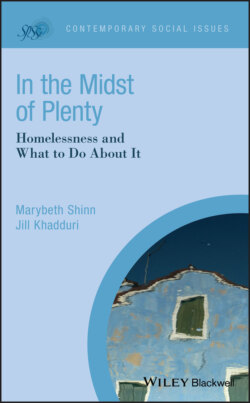Читать книгу In the Midst of Plenty - Marybeth Shinn - Страница 25
Summary
ОглавлениеIn this book, we focus on literal homelessness—staying in a place not intended for people to sleep (unsheltered homelessness) or in a shelter or transitional housing program for homeless people (sheltered homelessness). Broader definitions would include more people.
Relying largely on two sources of information—point‐in‐time counts conducted by all communities across the country on a single night in January and data from shelter records from those same communities over the course of a year, we examine people in five overlapping groups developed to help governments and social service systems respond to homelessness: families with children, adults without children, youth, veterans, and people with chronic patterns of homelessness. We note that seemingly basic distinctions are often shaped by service systems, such as family shelters that do not admit men. More men than women experience homelessness in the U.S., infancy is the age at which a person is most likely to be found in a homeless shelter, and African Americans and Native Americans are at especially high risk.
The face of homelessness has changed over time, both in the run‐up to the modern era of homelessness when younger people, including women and minorities, replaced older white men, and in the past decade when social policies have led to a reduction in homelessness, especially for veterans and people with chronic patterns. In the past decade we have also seen that single adults who experience homelessness are getting older.
We estimate the total number of people experiencing literal homelessness over a day (600,000), a year (1.6 million) and a lifetime (over 7.4% of the entire population, based on a telephone survey from 1990—and nearly twice that percentage if we include precarious housing). The numbers are much larger over longer time periods because most people who experience homelessness do so only briefly and then return to housing. Understanding this fact leads to multiple points of intervention to prevent people from becoming homeless and to help them return to housing.
Finally, we examine the challenges people who experience homelessness face. A PIT count may exaggerate those challenges, for several reasons. First, people with more challenges may have trouble extricating themselves from homelessness, so are more likely than those with fewer challenges to be surveyed on any particular date. Second, people's challenges depend in part on their circumstances and can be reduced by restoring them to housing.
